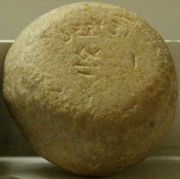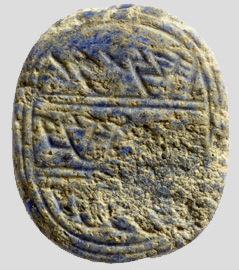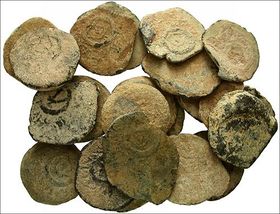White stones: Difference between revisions
No edit summary |
No edit summary |
||
| Line 39: | Line 39: | ||
The seal is is engraved on a semi-precious stone with the name of its owner “למתניהו בן הו…” (or “Lematanyahu Ben Ho…”) meaning “Belonging to Matanyahu Ben Ho…”. | The seal is is engraved on a semi-precious stone with the name of its owner “למתניהו בן הו…” (or “Lematanyahu Ben Ho…”) meaning “Belonging to Matanyahu Ben Ho…”. | ||
It is more likely the individual would only be given a token like the Roman ''[[Tesserae|tesserae]]'' evidence of your entitlements.[[Image:tesserae-lead-Alexander-Jannaeus.jpg|link=Tesserae|280px|right|thumb|]] | It is more likely the individual would only be given a token like the Roman ''[[Tesserae|tesserae]]'' evidence of your entitlements. | ||
[[Image:tesserae-lead-Alexander-Jannaeus.jpg|link=Tesserae|280px|right|thumb|]] | |||
The Roman authority of the [[world]] was far more centralized in its distribution of welfare than the traditions of Judea allowed. In local synagogues people knew each other. And there were the scribes who kept excelent records of all those who were [[Are _Christians_Idiots|registered]]. | The Roman authority of the [[world]] was far more centralized in its distribution of welfare than the traditions of Judea allowed. In local synagogues people knew each other. And there were the scribes who kept excelent records of all those who were [[Are _Christians_Idiots|registered]]. | ||
| Line 54: | Line 56: | ||
Most Christians at first were Jews as thousands of Jews followed Christ and formed together an alternative society based on faith, hope and charity having been cast out of the system of [[Corban]] set up by Herod. But the practice of using of carved stones to represent the ministers of service remained with the people. | Most Christians at first were Jews as thousands of Jews followed Christ and formed together an alternative society based on faith, hope and charity having been cast out of the system of [[Corban]] set up by Herod. But the practice of using of carved stones to represent the ministers of service remained with the people. | ||
Artifacts found in a baptismal grotto included a marble block with a Messianic Seal of the Church at Jerusalem. [[File:baptismalmarbleblock.jpg|right]] | |||
Artifacts found in a baptismal grotto included a marble block with a Messianic Seal of the Church at Jerusalem. | |||
[[File:baptismalmarbleblock.jpg|right]] | |||
The oil jar must have been set on the block. The marble has an archaic Aramaic inscription on it saying, "La Shemen Ruehon,"For the oil of the Spirit. This particular Seal of the Church of Jerusalem on the block has a tiny etched cross in the fish's eye, another thing to make sure we understand the symbol. Since Christ is our Rock and the source of the oil of the Holy Spirit, I am not surprised that the oil jar was set on the fine grained marble rock. | The oil jar must have been set on the block. The marble has an archaic Aramaic inscription on it saying, "La Shemen Ruehon,"For the oil of the Spirit. This particular Seal of the Church of Jerusalem on the block has a tiny etched cross in the fish's eye, another thing to make sure we understand the symbol. Since Christ is our Rock and the source of the oil of the Holy Spirit, I am not surprised that the oil jar was set on the fine grained marble rock. | ||
| Line 62: | Line 67: | ||
Hanway remarks ("Iruv.'i. 317.) that "the Persian ink serves not only for writing, but for subscribing with their seal ; indeed many of the Persians in high office could not write. In their rings they wear agates, which serve for a seal, on which is frequently engraved their name, and some verse from the Koran." ORIENTAL CUSTOMS. SAMUEL BURDER, VOLUME I.PHILADELPHIA, MAY 7th, 1807. | Hanway remarks ("Iruv.'i. 317.) that "the Persian ink serves not only for writing, but for subscribing with their seal ; indeed many of the Persians in high office could not write. In their rings they wear agates, which serve for a seal, on which is frequently engraved their name, and some verse from the Koran." ORIENTAL CUSTOMS. SAMUEL BURDER, VOLUME I.PHILADELPHIA, MAY 7th, 1807. | ||
"The men wear one ring on their right hand, on which is engraved their name; most of them are unable to read or write, and the stamp (khittem) on the ring (khatem) is employed to seal any act, sale of land, or other contract. The seal and ring are made one for the other, and are rarely considered as ornaments, with the men at least, and being naturally very necessary in public or business life, they are seldom confided to | "The men wear one ring on their right hand, on which is engraved their name; most of them are unable to read or write, and the stamp (khittem) on the ring (khatem) is employed to seal any act, sale of land, or other contract. The seal and ring are made one for the other, and are rarely considered as ornaments, with the men at least, and being naturally very necessary in public or business life, they are seldom confided to another." A Diary of My Life Holy Land, BY A. E. BREEM, Rochester, N. y. John P. Smith Printing Company 1906 | ||
another." A Diary of My Life Holy Land, BY A. E. BREEM, Rochester, N. y. John P. Smith Printing Company 1906 | |||
There is a legend that goes back to those who were forced as laborers to build Solomons temple wore engraved rings with their name and what was called the Seal of Solomon composed of inverted triangles, male and female. | There is a legend that goes back to those who were forced as laborers to build Solomons temple wore engraved rings with their name and what was called the Seal of Solomon composed of inverted triangles, male and female. | ||
Revision as of 09:00, 19 March 2018

Long before the Bible was written men carved stone to identify those in authority and those under authority. There are thousands of such stones and seals for sale online of RARE EARLY SUMERIAN STONE SEAL, ca. 4000-3000 BC. As an example you can see the white stone seals of hemispheric form with the flat surface engraved with three large and seven small depressions. Drilled horizontally. 21mm. Such rare early seals are thought to be precursors to written language and are very collectible. They can be purchased today for prices ranging around $450.

There have also been found hockey puck sized seals used to generate evidence of authority in the 7th century BC inscribed in Paleo-Hebrew. There are always one of two forms of government. Ones that rule over the people where some people are in charge of everyone else under a chain of command or free governments where the people exercise responsibility and the right to choose. The latter elect public servants and control the flow of support in the form of free will offerings while the former operates like Cain's city state or Nimrod's Babylon or Pharaoh's Egypt or Caesar's Rome, etc..
Both governments need to identify their connecting points in a network of exercising authority or loving service. They often do that with objects or symbols to identify them.
“And it shall be on the day when ye shall pass over Jordan unto the land which the LORD thy God giveth thee, that thou shalt set thee up great stones, and plaister them with plaister:” Deuteronomy 27:2
The stones were to be plastered white. This whitewash was made by burning bones to make lime plaster. This is symbolic of being clothed in white linen or the white stones mentioned in Revelation 2:17. These white stones were representative of men of good character, tested by fire and pure of heart.
“And thou shalt write upon them all the words of this law, when thou art passed over, that thou mayest go in unto the land which the LORD thy God giveth thee, a land that floweth with milk and honey; as the LORD God of thy fathers hath promised thee.” Deuteronomy 27:3
They were also to have the law written upon them before they passed over the Jordan. Does anyone really imagine that the God of the universe cares whether you cover stones with plaster or write words on them? Or is there a message in these rituals?
God makes it clear throughout the Bible that he wishes to make a covenant with men by writing His laws upon their hearts and minds, not upon dead stone. These stones and altars were an external reminder of the precepts of God. In some ways, they better understood the practical necessities of the day than the learned seminarians and their professors do today.
In the book Thy Kingdom Comes there is a reference to Barbara Thiering's book Jesus and the Riddle of the Dead Sea Scrolls:
- "Herod the Great had a grand scheme of a vast worldwide membership. This involved sending evangelists out all over the world. The participants of this system of social security were ritually baptized after an application and payment to Herod’s ministers of the prescribed fees. Annual contributions would be collected and recorded by the scribes."
- "Membership was marked by the display of a white stone seal or token with a registered Hebrew name whenever entering homes for the weekly gatherings or at synagogues or temples and applying for social benefits. The temple tax collectors now collected an annual contribution that brought great wealth to the government, Herod, and his administrators."
- “The missionaries… with their leather wallets full of white stones, would come back with the same wallets full of money, in foreign currency. Once put into Jewish currency by the money-changers [porters of the temple], it would be stored in vaults, ready to be used by Herod for his vast building projects, or any subsequent causes.”
- “Herod’s scheme of initiation into a new form of Judaism was immensely successful. Jews everywhere were willing to join the worldwide society whose meetings were held in the evenings in private houses. Entry was for members only; they had to show at the door an admission token in the form of a white stone from the river Jordan which the missionaries gave them at baptism. On the stone was written their new Jewish name.” [1]
- Herod had been sending out his Pharisee missionaries and teachers, who supported his idea of a vast kingdom of God on earth, for some time. It was a system of social security (Corban) and commercial affluence. Those ministers preached a prosperity gospel with a religious stamp of approval and statutory enforcement of the taxes required for its support.
It appears that it was her conclusion that every individual received a white stone for personal identification. It is more likely that individuals were merely registered and ministers of synogogues or assemblies received an official stone that could be used as a seal.
Such seals were common in the history of the Jews to use stones to create seals for officials who were to keep track of the people within a network.
Archeology has produced at least one such personal seal from the First Temple period bearing the name Matanyahu (Clara Amit / the Israel Antiquities Authority)

The seal is is engraved on a semi-precious stone with the name of its owner “למתניהו בן הו…” (or “Lematanyahu Ben Ho…”) meaning “Belonging to Matanyahu Ben Ho…”.
It is more likely the individual would only be given a token like the Roman tesserae evidence of your entitlements.

The Roman authority of the world was far more centralized in its distribution of welfare than the traditions of Judea allowed. In local synagogues people knew each other. And there were the scribes who kept excelent records of all those who were registered.
If you were registered your birth was registered in Rome you could get a tesserae issued by the state to obtain benefits.
The custom of engraving stones with names reaches to the earliest practices of Israel.
- Exodus 28:11 With the work of an engraver in stone, like the engravings <06603> of a signet, shalt thou engrave the two stones with the names of the children of Israel: thou shalt make them to be set in ouches of gold.
- Exodus 28:21 And the stones shall be with the names of the children of Israel, twelve, according to their names, like the engravings <06603> of a signet; every one with his name shall they be according to the twelve tribes.
And even at the end of the Bible in Revelation 2:17 we see
- "He that hath an ear, let him hear what the Spirit saith unto the churches; To him that overcometh will I give to eat of the hidden manna, and will give him a white stone, and in the stone a new name written, which no man knoweth saving he that receiveth [it]."
Most Christians at first were Jews as thousands of Jews followed Christ and formed together an alternative society based on faith, hope and charity having been cast out of the system of Corban set up by Herod. But the practice of using of carved stones to represent the ministers of service remained with the people.
Artifacts found in a baptismal grotto included a marble block with a Messianic Seal of the Church at Jerusalem.

The oil jar must have been set on the block. The marble has an archaic Aramaic inscription on it saying, "La Shemen Ruehon,"For the oil of the Spirit. This particular Seal of the Church of Jerusalem on the block has a tiny etched cross in the fish's eye, another thing to make sure we understand the symbol. Since Christ is our Rock and the source of the oil of the Holy Spirit, I am not surprised that the oil jar was set on the fine grained marble rock.
The custom of using engraved stones or even baked clay as identification has been very common.
Hanway remarks ("Iruv.'i. 317.) that "the Persian ink serves not only for writing, but for subscribing with their seal ; indeed many of the Persians in high office could not write. In their rings they wear agates, which serve for a seal, on which is frequently engraved their name, and some verse from the Koran." ORIENTAL CUSTOMS. SAMUEL BURDER, VOLUME I.PHILADELPHIA, MAY 7th, 1807.
"The men wear one ring on their right hand, on which is engraved their name; most of them are unable to read or write, and the stamp (khittem) on the ring (khatem) is employed to seal any act, sale of land, or other contract. The seal and ring are made one for the other, and are rarely considered as ornaments, with the men at least, and being naturally very necessary in public or business life, they are seldom confided to another." A Diary of My Life Holy Land, BY A. E. BREEM, Rochester, N. y. John P. Smith Printing Company 1906
There is a legend that goes back to those who were forced as laborers to build Solomons temple wore engraved rings with their name and what was called the Seal of Solomon composed of inverted triangles, male and female.
According to a ancient legends they represented a union like that of male and female, or family. Those that had the rings were servants of Solomon and or taskmasters of Solomon who compelled the people to serve under tribute.
Stones have been believed to have been dated from that period were found bearing inscriptions in Iberian-Punic (from Phoenician-Hebrew), Egyptian, and ancient Libyan showing the alliance of Solomon.
The points of the hexagram can be connected to form a hexagon and is similar to the more ancient Hindu Shatkona. Within Kabbal mystiscim forms like the Sefirah Tifaret ar calculated. But all this was symbols of a social structure where some people ruling over one another by agreement. The resulting exercising authority granted to obtain benefits of protection and security often brings out a beast nature of man in those with power where that power is abused and many are oppressed.
- Proverbs 1:10...33 "My son, if sinners entice thee, consent thou not.... Cast in thy lot among us; let us all have one purse:... My son, walk not thou in the way with them;.... they lay wait for their own blood;... Therefore shall they eat of the fruit of their own way, and be filled with their own devices."
- Psalms 69:22 Let their table become a snare before them: and that which should have been for their welfare, let it become a trap.
- Romans 11:9 And David saith, Let their table be made a snare, and a trap, and a stumblingblock, and a recompence unto them:
Footnotes
- ↑ Jesus and the Riddle of the Dead Sea Scrolls by Barbara Thiering, Harper Collins: 1992